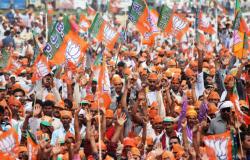“Normal Service May Not Be Resumed”

Brian Stoddart argues that choosing the lesser of two political evils is the new global normal.
It is now a truism to note that politics in the West are either in transition, “disrupted”, or even broken. All the old principles and operating rules are long gone as Trump becomes normal in the United States where the Democrats demonstrate no clear response; as Theresa May retreats in the United Kingdom where both major parties are dismantled by Brexit confusion; as Austria’s dalliance with the far right takes on complex forms; and as Italy, among others, also moves to the right in the form of Matteo Salvini and the League.
That is, the abnormal has become the normal, as seen yet again in the recently conducted Indian and Australian national elections. Both results were unexpected, if for different reasons.
In India, Prime Minister Narendra Modi’s Bharatiya Janata Party (BJP) returned with a landslide majority when the opposition alliance had been expected to do well, or at least much better than in 2014. Australia was even more sensational because, according to any partisan voter’s specific wish, the Australian Labor Party led by Bill Shorten “lost the unlosable” or upstart Prime Minister Scott Morrison “won the unwinnable” with the Liberal-National party coalition not only staying in power but increasing its majority.
Psephologists and other political nerds in both nations will take time to read all the entrails of these results, but one thing is clear: the Indian National Congress and the Australian Labor Party both need major redirection yet neither seems immediately aware or capable of doing so.
In 1885 the Indian National Congress began pressuring the British into conceding political power to Indians, and soon set the goal as full political independence that arrived in 1947. By then and for some time after it was the natural party of power, led by Jawarharlal Nehru then daughter Indira Gandhi. Regional parties began challenging that Congress ascendancy, especially in the south, and during the 1980s the BJP and similar parties began gaining ground. While Atal Bihari Vajpayee led a BJP government between 1999 and 2004, he was bookended by Rajiv Gandhi and Manmohan Singh, the latter heading a Congress-dominated alliance until 2014.
From 1947 until 2014, that is, Congress could mostly command a natural majority either in its own right or in collaboration with other groups. But it was obliterated at the 2014 polls, winning just 44 out of the 543 available seats in its own right. This time it won more, 52, but still failed to get the minimum 55 needed to become the official opposition. And symbolically, Congress lost the Nehru-Gandhi traditional seat of Amethi in Uttar Pradesh for the first time ever.
Within twenty years, the party has descended from dominant to almost disappeared and as Nalin Mehta suggests, that in turn has inverted most things.
The Australian Labor Party has not done that, but it has now won outright just one federal election (2007) in twenty six years and its primary vote is stuck persistently in the 25-35% zone from which it is almost impossible to win office. Its problem this time was that it expected to win against a government that was divided, directionless and derided. Opinion polls without exception saw no other possible result – as a few cognoscente pointed out, to the few who listened, those opinion polls are based on calls to landline telephones in an age when mobiles predominate and have done so for some time. And, of course, deep demographic impulses lie in in there. Younger generations almost exclusively rely on mobiles while landlines are the preserve of (a few of) older ones. Even so, the belief was widespread – Labor would win.
So why did it lose? Defeated leader Shorten blamed “vested interest”, “powerful influences”, anything and anyone that did not involve errors of judgment on his or the party’s part. But his 1950s and 60s “class warfare” rhetoric grated on an increasingly compromised and complicated electorate. For example, tradies (skilled workers like plumbers, builders and electricians) generally voted Labor until the last decade or two, but as their numbers thinned and a housing and resources boom took off, they became in demand and affluent. So, when Shorten took on “the top end of town” he was also attacking them, his “own people”. That was aggravated by a threatened raid on superannuation funds and investment properties, which tradies have as well. Then in job-scarce Queensland, Labor threatened to halt development of a massive coal mine. The party’s traditional supporters there deserted in droves.
Perhaps put too generally, there is a clue in here for both the Australian and India situations: for both Congress and Labor the traditional reasons for their popular support have disappeared and/or changed substantially, and their founding ideology is no longer meaningful in its current form.
To unpack that on the most basic level in India, being the party to have won independence no longer matters. That was seventy two years ago, when it only took sixty two years to win that freedom. The electorate now is fixed firmly on India’s prosperity and its place in the world, and Prime Minister Modi played to that with spectacular success. Not for him the non-alignment of Nehru and Congress, he is right into the language and relationships of the G7 and that plays to all India’s big business leaders, entrepreneurs and the massive diaspora that now dominates the Silicon Valley and big corporations internationally. That is the level of the contest in which Congress must engage.
And Modi has managed to advance the BJP’s driving Hindutva philosophy yet simultaneously avoid it becoming a major liability domestically and/or internationally. Put bluntly, the BJP’s intellectual pulse begins and ends with the idea of advancing Hindu interests at the expense of anyone else, namely Muslims, and is virulently anti-Pakistan. Ironically, though, right now India is the world’s second most populous Muslim country, behind Indonesia. But by 2050 it will likely to be the largest with Muslims making up 18% of the national population with that percentage tipped to rise to 20% or greater by 2100.
This became an election issue, the BJP accusing Congress of being pro-Muslim as its leader Rahul Gandhi staged discussions with Muslim leaders. That battle will continue post-election as observers like Zakia Soman suggest that, among other things, Congress must rediscover the inclusiveness and plurality that drove its agenda in the first place. That would be a major distinction between it and the BJP.
The Labor Party’s challenge is less dramatic, perhaps, but its response must be as thorough going. For example, the party is now uneasily aligned with the trade unions that themselves have undergone change necessarily. As implied in the name, Labor formed through the 1890s then became a formal federal party, in 1901, ostensibly to protect and project the interests of the working man. (Gender inclusiveness is now a huge issue in Australian politics and, in short order, Labor went from pre-election boasting about its own claims of superiority over the government in that respect to a few days later desperately shoring up its position with women in the new phase of opposition.) As union membership has declined and more aggressive unions become less palatable to the voting public, that old alliance has come under attack. That was confirmed during the election with party and peak union body at odds in one high profile seat over precisely how to vote for candidates under Australia’s preferential voting system.
What all that means is that both Congress and Labor must set radically new directions from the leadership down, and that does not appear likely to occur.
Bill Shorten immediately campaigned against his likely successor, then there was an unseemly public bargaining for parliamentary positions in opposition between the party’s various Left and Right factions. Among other things, that led to a very new Senator becoming deputy leader when she had led the New South Wales party to its greatest ever state electoral defeat. For the voting public, that looks like more of the same, especially as the new federal leader lost to Shorten in the intra-party elections last time round – it looks like it was “his turn” now rather than what the party needs in a vastly different environment.
Rahul Gandhi, the latest in a long line of Nehru-Gandhi Congress grandee leaders, laid some blame for the big loss on members of the party trying to promote the political interests of their sons, and at the same time dithered about his own future. As in Australia, that looks to the voting punters like privileged self-interest when the tide had turned, perhaps no better demonstrated than in the exit from parliament of Jyotiraditya Madhavrao Scindia having lost the Guna seat in Madhya Pradesh. From the former Gwalior princely family, he held the seat from 2002 having succeeded his father and grandfather there – the BJP cast that as a choice between nationalism and dynasty.
Of course, that immediately raises the question as to how the triumphant parties got there, and how the losers will deal with that.
As in 2014, in India this was very much about how voters regarded Modi and Gandhi, the new and the old. Try as he might, Rahul seems to represent the past while Modi has his foot to the floor propelling India internationally to where most Indians think it should be now. While Modi was as much about the common person as Gandhi and the Congress, he was way ahead on foreign policy (more specifically foreign profile), economic growth and modernisation. This was about aspiration, and Congress somehow must deal with that and, so far, has not.
In Australia, social aspiration and leadership is a hot topic for electoral strategists. Shorten entered the election with one of the persistently lowest ever ratings as “preferred prime Minister”. There is something about him electors do not like. Perhaps it was his being just the latest incarnation of a professional politician–trades union official turned politician. Perhaps it was the robotic kneejerk response to one question that always answered another. Perhaps it was the widespread thought that he stood for whatever was the exact opposite of the government’s position. (In both India and Australia, many voters would welcome a return to some element of a bipartisan position on at least some policy matters).
Whatever it was, Shorten could not cut through. On the other, hand Scott “Scomo” Morrison transmogrified into “ScoMoses” as he pulled off the impossible. He basically profiled Shorten as the man intent on robbing voters through new taxes and charges. It worked because Shorten found no way to pitch that differently let alone positively. Like Rahul Gandhi, he seemed stuck in the past. Not that Scomo is any Modi, far from it, but he did paint his party as responsible managers of the government purse who would deliver a better future.
And it should be said here that both successful parties themselves have started the necessary renewal, perhaps more in Australia than India. The new Morrison Liberal-National government might best be regarded as a Tory one, because it now bears more resemblance to the British Conservative party’s outlook than it does to any Liberal one. Several moderate, “liberal”, figures, anticipating disaster, abandoned ship before the election. The result is a more conservative outlook, something else Labor might consider as it charts its new course.
In India the departure of senior figures like Arun Jaitley and Sushma Swaraj has opened the way for new figures and directions - the appointment of Subrahmanyam Jaishankar as new Foreign Affairs Minister is a master stroke. While born in Delhi he is the son of a prominent south Indian Brahmin, brother to noted historian Sanjay Subramanyam, and recently retired as India’s most senior diplomat. He provides both expertise, especially on China, and a nod to the south where regional parties still stubbornly resist the BJP sweep. Again, that sort of appointment is what Congress needs in order to strengthen its own ranks and appeal.
As the world muddles into this new order of political behaviours, these two elections point to some overall strands becoming more universal in democratic sites where elections determine who governs.
There is a clear message that parties should not rely on history. Narendra Modi too easily painted Rahul Gandhi as an elitist relic. Styling himself as a successor to Gough Whitlam meant that Shorten allowed Morrison to undermine Labor’s money management ability, the Whitlam government having been a disaster in that respect. That rejection of past political tradition was seen in France with Macron, for example, and replayed in the United Kingdom where traditional Toryism is on full display but countered poorly on the other side by a return to Fabian Socialism in Jeremy Corbyn. Voters like neither.
Westminster democracies are becoming more like the American one. The leader is now a Presidential candidate. Rahul Gandhi and Bill Shorten could not make themselves popular enough to see off their opponents. Shorten’s successor has already tried to make himself look “different”, but for much of the electorate he is the same type in a different form and no more competitive against Morrison. Modi ran a model Presidential campaign. Trump won in good measure because he painted Hillary Clinton as untrustworthy.
And that is where the media comes in, especially its social variant. As Modi and the Liberal-National coalition both demonstrated, social media both broadcasts the general “presidential” persona but at the same time can target the most local of issues and the smallest of electoral bases. This will become even more sophisticated and increasingly based on “big data” analyses that target particular groups. They who have the best big data will most likely win. Narendra Modi has 47.5 million Twitter followers, almost five times more than Rahul Gandhi and he won almost six times as many seats. That is a rough but telling proxy.
There is a link here to voter turnout. In a country where voting is not compulsory, India saw a record turnout this year with around 67% of eligible voters casting a ballot, and women’s participation noticeably higher than ever. The Modi media factor rates high as a cause of that. In Australia, however, where voting is compulsory, this was the lowest turnout since the 1920s, young people especially staying away. Perhaps the Australian parties’ social media campaigns were not strong enough with SnapChat, WhatsApp and Instagram.
And that underscores the idea of not trusting the polls, even private ones that all parties now run. We are perhaps in a transitionary period where the old methods are obviously obsolete but the new ones not yet clarified. As with campaigning, predictions will become increasingly linked with big data but until that is fully proven, all bets might be off.
Finally, one view in Australia is that Shorten and Labor laid out too many specific policies that opened them to attack and to the challenge of communicating those policies to voters. Really, the issue was about voter sensitivities and the inability to argue those policies coherently. Voters now seek certainty and will switch votes to where they think they might get it. In so many elections now the choice is between the evil of two lesser and, on that basis, Morrison got up. Macron laid out a vision he cannot deliver and is suffering as a result. Britain unexpectedly voted for BREXIT and the Conservatives cannot deliver, to voter chagrin. Voters need clarity, conviction, and confidence. Modi and Morrison delivered that, Gandhi and Shorten did not.
There is much to watch in the immediate aftermath of these unexpected results then, and how the losers react will affect not only their own future prospects but also the shape of the new politics that might impact on the growth of their respective countries.
Brian Stoddart is Emeritus Professor at La Trobe University in Melbourne, Australia where he served as Vice-Chancellor, a higher education consultant internationally, a regular commentator on global issues, cruise ship lecturer, and a crime fiction writer.
Image credit: Narendra Modi via Flickr (CC BY-SA 2.0)


